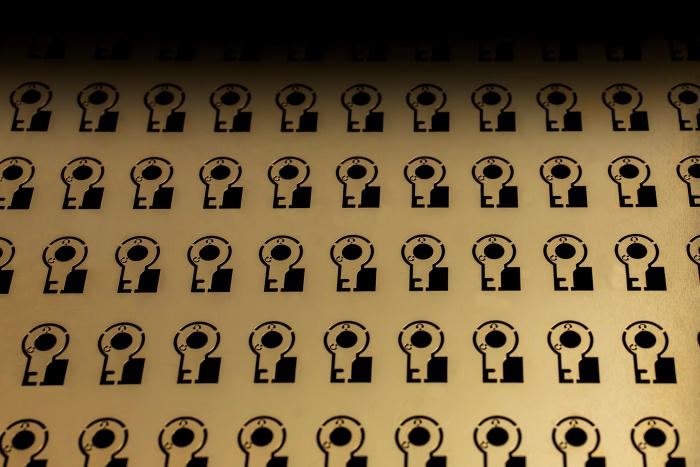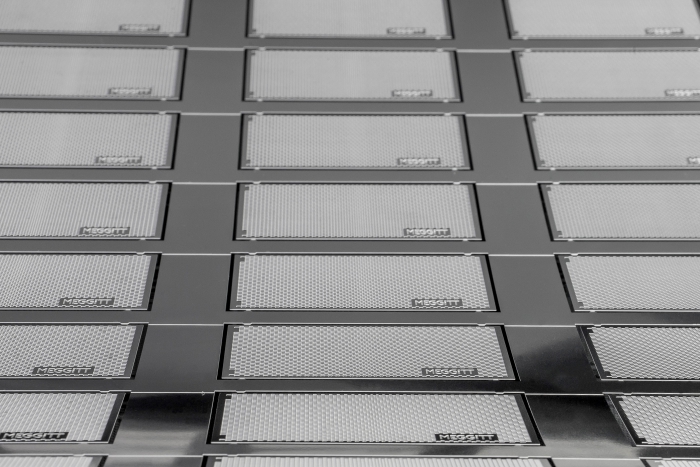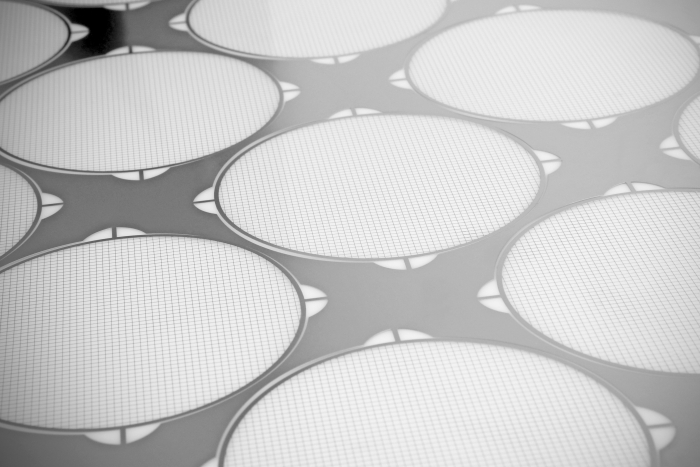Photo etching is a fast, efficient and cost-effective method for the manufacture of small precision metal parts using etchant chemistries. It is well-suited for development, prototype and production volumes, and has the ability to ramp up from low- to high-volume runs extremely quickly. Photo etched parts are burr and stress-free, the complexity of shape is unlimited, and there is absolute flexibility to change the design at any time as the process uses easily altered digital tooling.
It is these attributes which makes photo etching attractive for a vast range of complex parts and components, many of which are used in safety-critical applications. Importantly, however, photo etching has another key attribute—its ability to be applied to almost any metal. This is a product of two things: the inherent nature of the process, and in respect of Precision Micro, decades of R&D in etchant chemistries.

Photos courtesy of Precision Micro
One-size fits all?
Photo etching is not a one-size fits all process. To achieve optimal results for customers from across all industry sectors, a production photo etching specialist has to partner with its customers, get under the skin of a particular project and, of course, optimize process parameters and etchants appropriate to a particular metal to guarantee success. Precision Micro, for example, can apply photo etching to more than 2,000 metal types.
Virtually any metal can be photo etched, but some—such as stainless steel, copper and nickel — are more straightforward than others—such as aluminium and titanium. There is a growing demand from industry for metals that are stronger, lighter and generally higher performance, while still working within strict cost parameters. Often it is these metals that are more difficult to machine economically.
Below, the key metal groups that customers demand are explained, as is the approach to photo etching and typical components manufactured.
Steel and Stainless Steels
Precision Micro etches more than two million steel components each month from a range of austenitic (300) and martensitic (400) series steel grades, as well as specialty grades, which exhibit high fatigue strength such as Sandvik Chromflex strip steels.
Due to its versatility, stainless steel is used in a variety of products and applications, and is often preferred because of its relatively low cost.
Stainless steel springs and flexures are used in safety-critical applications, such as satellites, ABS braking systems, biosensors and fuel injection systems. In these applications, flexures need to “flex” millions of times faultlessly, and, as photo etching does not alter the fatigue strength or flatness of stainless steel, it is often viewed as the optimal process.
Photo etching is also used extensively in the manufacture of custom steel meshes, filters and sieves as, unlike conventional sheet metalworking, the process offers unlimited complexity—you only pay for the first hole. Also, as photo etching does not alter the mechanical surface finish of stainless steel, it has been adopted by automotive interior trim designers for the manufacture of complex and detailed premium automotive speaker grilles.
In the medical sector, surgical grade steels with high degrees of hardness are etched to produce a range of surgical instrument, including sagittal and oscillating bone saws. Etchant chemistries handle both hard and soft materials equally well, unlike stamping where harder materials result in tool wear and subsequent refurbishment.

Nickel and Nickel Alloys
Nickel exhibits high resistance to heat and corrosion and is commonly used as a protective outer coating for softer metals. Precision Micro etches a variety of nickel components for the medical industry, including electrical hearing aid contacts and components for use in active implant battery capacitors.
Nickel silver is the most cost-effective material choice for electronics shielding as it can be soldered, will not oxidise and requires no additional plating. Digital photo-tooling offsets expensive press tools, and bend lines can be incorporated so components can be formed by hand.
Inconel is a high-temperature, nickel-based superalloy, which offers superior heat resistance and exhibits excellent resistance to corrosion, pressure and oxidation. It is these properties which make it difficult to machine and indeed photo etch. However, as a “hard-to-machine metal” etching specialist, Precision Micro has developed a propriety process for photo etching Inconel, producing fuel cell plates with complex bipolar etched channels and flow discs that come into contact with corrosive gases.
Copper and Copper Alloys
Copper is often specified for electronics applications because of its high thermal and electrical conductivity. Its properties (as is the case with other metal types) can be enhanced for specific applications by creating an alloy with another metal. For example, adding beryllium increases the physical strength of copper.
Copper and its alloys are highly durable, ductile and malleable, meaning it is well-suited to forming and plating post-etching. Examples of parts include 3D electrical contacts, pins, terminals, EMI gaskets, shielding, lead frames and connectors for automotive, electronics, aerospace and medical applications.
Titanium and its Alloys
Titanium is renowned for its strength, light-weight, high-temperature performance and biocompatibility. Etching titanium is difficult because it forms a protective oxidised coating when exposed to air, meaning it cannot be etched with standard etch chemistries. To overcome this problem, special etchant chemistries are needed.
Precision Micro specialises in etching biocompatible cranial, dental, and pacemaker battery meshes for the medical devices market. These complex and sometimes ultrathin meshes benefit from the fact that photo etching manufactures all openings and counter sinks simultaneously, therefore making it more economical than competing laser cutting and machining processes.
By combining photo etching and diffusion bonding, complex, captive channels in plate heat exchangers can be produced more economically than conventional machining or laser drilling.

Aluminium and its Alloys
Aluminium exhibits many of the attributes of titanium—notably its high strength to weight ratio and natural corrosion resistance—but at a lower cost. Whereas titanium is stronger and more corrosion resistant than aluminium, it has a relatively low fatigue limit, which makes aluminium well-suited to aerospace applications where fatigue limits must be high.
Aluminium is difficult to photo etch effectively as the heat energy it releases during etching often results in a rough, granular edge.
Precision Micro has developed a proprietary method for etching aluminium and its alloys, producing edge profiles comparable with those etched in stainless steel.
Typical applications include helicopter air intake grilles, which are lightweight and retain material properties during manufacture, and heat transfer plates for aircraft dehumidifiers and engines. These plate assemblies often require multiple designs, which can be set up cost-effectively with photo etching, and include smooth channels to improve airflow.
Highly versatile and cost-effective, it is no wonder photo etching has become one of the fastest growing metal machining technologies. An ability to etch the widest range of metals is crucial when specifying a photo etching supplier, as is partnering early in the design phase to ensure success in manufacture and a quicker route to market.
Related Glossary Terms
- alloys
alloys
Substances having metallic properties and being composed of two or more chemical elements of which at least one is a metal.
- burr
burr
Stringy portions of material formed on workpiece edges during machining. Often sharp. Can be removed with hand files, abrasive wheels or belts, wire wheels, abrasive-fiber brushes, waterjet equipment or other methods.
- copper alloys
copper alloys
Copper containing specified quantities of alloying elements added to obtain the necessary mechanical and physical properties. The most common copper alloys are divided into six groups, and each group contains one of the following major alloying elements: brasses—major alloying element is zinc; phosphor bronzes—major alloying element is tin; aluminum bronzes—major alloying element is aluminum; silicon bronzes—major alloying element is silicon; copper-nickels and nickel-silvers—major alloying element is nickel; and dilute-copper or high-copper alloys, which contain small amounts of various elements such as beryllium, cadmium, chromium or iron.
- diffusion
diffusion
1. Spreading of a constituent in a gas, liquid or solid, tending to make the composition of all parts uniform. 2. Spontaneous movement of atoms or molecules to new sites within a material.
- fatigue
fatigue
Phenomenon leading to fracture under repeated or fluctuating stresses having a maximum value less than the tensile strength of the material. Fatigue fractures are progressive, beginning as minute cracks that grow under the action of the fluctuating stress.
- fatigue strength
fatigue strength
Maximum stress that can be sustained for a specified number of cycles without failure, the stress being completely reversed within each cycle unless otherwise stated.
- hardness
hardness
Hardness is a measure of the resistance of a material to surface indentation or abrasion. There is no absolute scale for hardness. In order to express hardness quantitatively, each type of test has its own scale, which defines hardness. Indentation hardness obtained through static methods is measured by Brinell, Rockwell, Vickers and Knoop tests. Hardness without indentation is measured by a dynamic method, known as the Scleroscope test.
- metalworking
metalworking
Any manufacturing process in which metal is processed or machined such that the workpiece is given a new shape. Broadly defined, the term includes processes such as design and layout, heat-treating, material handling and inspection.
- stainless steels
stainless steels
Stainless steels possess high strength, heat resistance, excellent workability and erosion resistance. Four general classes have been developed to cover a range of mechanical and physical properties for particular applications. The four classes are: the austenitic types of the chromium-nickel-manganese 200 series and the chromium-nickel 300 series; the martensitic types of the chromium, hardenable 400 series; the chromium, nonhardenable 400-series ferritic types; and the precipitation-hardening type of chromium-nickel alloys with additional elements that are hardenable by solution treating and aging.

